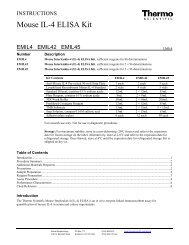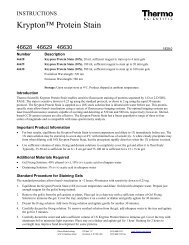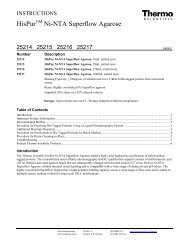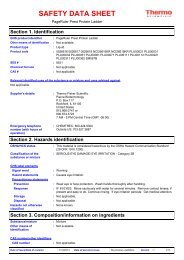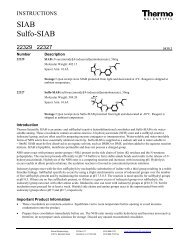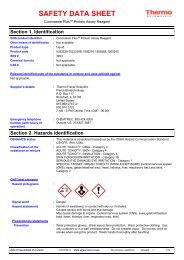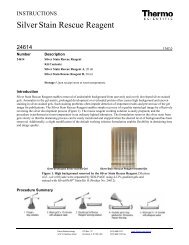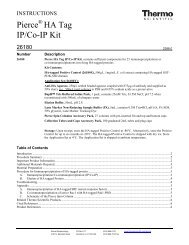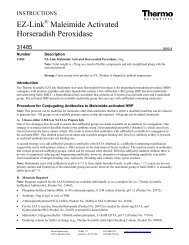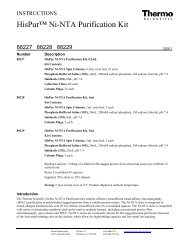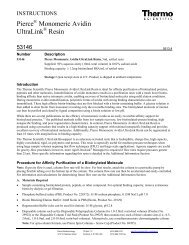Thermo Scientific Pierce Protein Assay Technical Handbook Version 2
Thermo Scientific Pierce Protein Assay Technical Handbook Version 2
Thermo Scientific Pierce Protein Assay Technical Handbook Version 2
Create successful ePaper yourself
Turn your PDF publications into a flip-book with our unique Google optimized e-Paper software.
Total <strong>Protein</strong> <strong>Assay</strong>s – Amine Detection<br />
o-Phthalaldehyde [OPA] Fluorescent<br />
<strong>Protein</strong> <strong>Assay</strong><br />
The <strong>Thermo</strong> <strong>Scientific</strong> <strong>Pierce</strong> Fluoraldehyde <strong>Protein</strong>/Peptide<br />
<strong>Assay</strong> is an o-phthalaldehyde-based reagent developed to detect<br />
minute amounts of protein and peptides. Fluoraldehyde reactions<br />
are complete in less than one minute with sensitivity down<br />
to 50ng/mL. While some solutions interfere with protein/peptide<br />
measurement at 280nm, our Fluoraldehyde <strong>Assay</strong> is compatible<br />
with many substances that interfere with other protein assays,<br />
such as detergents and reducing agents. Amine-containing buffers<br />
must be avoided, however, when performing assays using<br />
this chemistry.<br />
In the standard assay mode, the fluoraldehyde ready-to-use<br />
formulation can measure protein concentration in the range of<br />
10 to 500µg/mL, while the micro-assay working range is 50ng/mL<br />
to 25µg/mL.<br />
Our Fluoraldehyde <strong>Protein</strong>/Peptide <strong>Assay</strong> Reagent requires only<br />
200µL of sample for use in a microplate assay, saving valuable<br />
sample and time. Fluoraldehyde assays require an excitation<br />
wavelength of 360nm and emission wavelength of 455nm.<br />
OPA will react only with primary amines. When reacted with<br />
primary amines in the presence of mercaptoethanol, OPA yields<br />
an intense blue colored fluorescent product that has a maximum<br />
wavelength of excitation of 340nm and emission at 455nm. 1,2<br />
Wavelengths from 330-375nm have been used for excitation and<br />
436-490nm for measuring emission. <strong>Protein</strong> concentrations as low<br />
as 50ng/mL can be measured with an OPA assay. The inherent<br />
sensitivity and speed of OPA, along with its broad linear range,<br />
makes it a useful protein and peptide assay reagent.<br />
OPA is ideal for assaying peptides that do not contain tyrosine<br />
residues, or for other applications in which absorbance at 280nm<br />
cannot be used. <strong>Protein</strong>s and peptides tested yield linear results<br />
over a wide range of concentrations using both standard and<br />
microassay protocols.<br />
There is considerable protein:protein and peptide:peptide variation<br />
with the OPA assay; therefore, it is best to use a purified<br />
sample of the particular protein or peptide as the standard. When<br />
this is not possible, the next best option is to use a protein or<br />
peptide that gives a response similar to the sample. Alternatively,<br />
a commonly accepted standard protein such as bovine serum<br />
albumin can be used.<br />
Reducing agents and metal chelators do not interfere with an<br />
OPA-based assay, provided they are included in the blanks and<br />
standards. In addition, most detergents do not interfere. Any common<br />
sample buffers and constituents are also compatible, but<br />
primary amines such as Tris or glycine buffers will interfere with<br />
OPA and must be avoided. Acetylated and other primary amineblocked<br />
peptides will not give a response with OPA.<br />
References<br />
1. Ogden, G. and Foldi, P. (1987). LC•GC 5(1), 28-38.<br />
2. Roth, M. (1971). Anal. Chem. 43, 880-882.<br />
CHO<br />
+ H 2 N – Peptides + HS – CH 2<br />
– CH 2<br />
– OH<br />
CHO<br />
S – CH 2<br />
– CH 2 OH<br />
C<br />
N – Peptides<br />
The reaction of o-Phthalaldehyde with a primary amine on a peptide in the<br />
presence of 2-mercaptoethanol to form a fluorescent-labeled peptide.<br />
Fluoraldehyde o-Phthalaldehyde Crystals<br />
An easy, economical way to detect amino acids in pre- and postcolumn<br />
chromatographic effluents.<br />
Highlights:<br />
O<br />
H<br />
H<br />
O<br />
Fluoraldehyde<br />
o-Phthalaldehyde<br />
M.W. 134.13<br />
• Stable in aqueous solution<br />
• Highly sensitive, low<br />
background<br />
• Rapid analysis, no heating required<br />
Ordering Information<br />
Product Description Pkg. Size<br />
26015 Fluoraldehyde<br />
5g<br />
o-Phthalaldehyde Crystals<br />
References<br />
Lindroth, P. and Mopper, K. (1979). Anal. Chem. 51, 1667-1674.<br />
Lee, K.S. and Drescher, D.G. (1979). J. Biol. Chem. 254, 6248-6251.<br />
Van Eijk, H.M., et al. (1988). Clin. Chem. 34, 2510-2513.<br />
Graser, T.A., et al. (1985). Anal. Biochem. 151, 142-152.<br />
Cooper, J.D., et al. (1984). Anal. Biochem. 142, 98-102.<br />
Krishnamurti, C.R., et al. (1984). J. Chromatogr. 315, 321-331.<br />
Jones, B.N., et al. (1983). J. Chromatogr. 266, 471-482.<br />
Lee, H., et al. (1979). Anal. Biochem. 96, 298-307.<br />
Chen, R.F., et al. (1979). Biochem. Biophys. Acta 576, 440-455.<br />
Jones, B.N., et al. (1981). J. Liq. Chrom. 4, 565-586.<br />
30<br />
For more information, or to download product instructions, visit www.thermoscientific.com/pierce



